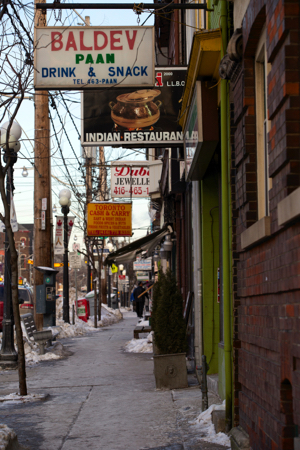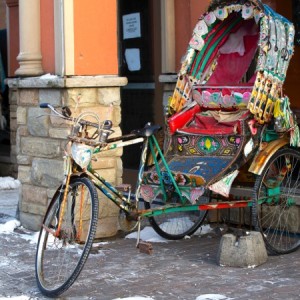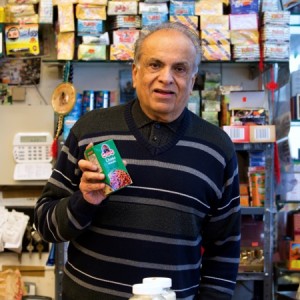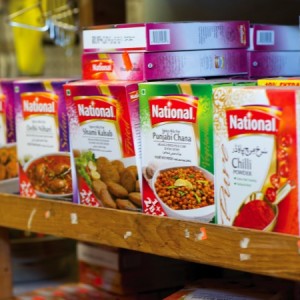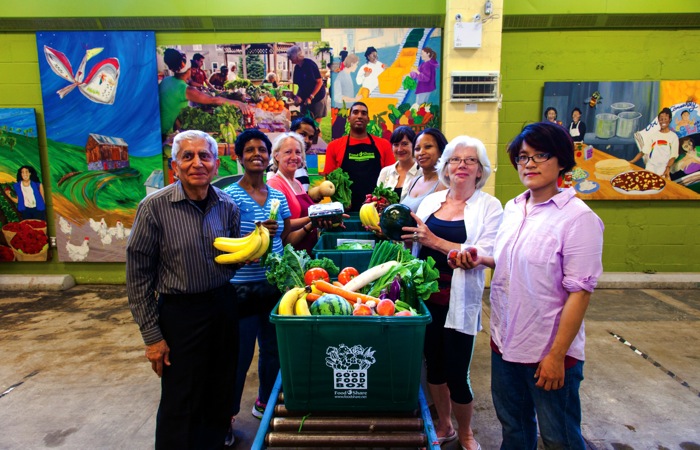It’s pretty clear that we don’t exactly know what we’re doing. The shopkeeper, looking through the window, sees our hesitation. He opens the door, looks at us, smiles, and waves us in. “Please come in,” he says.
Not familiar with this stretch of city shops, we had paused to peer in the window of a store called Toronto Cash & Carry. We don’t know where we’re going. We only know that we’ve been told we’ll be glad we made the effort to come here, and that we should be sure to buy the brand of chana masala spice blend that comes in a green box.
We have tried chickpea curry and liked it, and we’ve been thinking of making our own, and apparently this is where we must come for the best ingredients.
The shopkeeper’s friendliness is nice after the downturned faces on the standing-room-only 506 Carlton streetcar that we rode to get here. We were packed together like sardines, yet most people didn’t speak or make eye contact. Everyone was close; everyone was distant.
The 506 goes through nice and not-so-nice neighbourhoods. They sit cheek and jowl. We get on at Yonge Street, just before Maple Leaf Gardens. After a few minutes, the wheels screech as the tracks curve onto Parliament Street. To the east are restored Victorian homes and urban professionals. To the south, as we round the corner onto Gerrard Street, we’re sandwiched between thrift stores and the Regent Park housing project.
Finally there’s chatter when the woman in front of us suddenly spots a friend across the aisle of the streetcar. The woman has bought a new dress and shoes for tonight, she tells her friend, adding, “I’m going out tricking.” She’s indifferent to whether anyone overhears her.
She’s still chatting when we get off at Greenwood Avenue. We’ve already passed East Chinatown, with its Chinese and Vietnamese shops and restaurants, and we’ve arrived at the Gerrard India Bazaar shopping strip, which bills itself as the largest South Asian retail cluster in North America. Both are like little villages within the city, where food opens up barriers and conversation.
Walking past the Lahore Tikka House restaurant, we see rickshaws on the patio. This may not be an Anne-of-Green-Gables picture of Canada, but it is very definitely Canada, although here the clothing stores have brightly coloured, bejewelled clothes. In one store, which smells of incense, we look at English-language books on Hinduism, yoga, and diet. There are musical instruments we don’t know, and Indian carvings and crafts.
At Toronto Cash & Carry
The clerk holds the door as we go into Toronto Cash & Carry to look for the chana masala spice mix. He and the owner, Amin Vali, are quick to inquire what we’re looking for and take us to it.
Another shopper shares a laugh with my wife, Shelley, when she buys all but four of the samosas, and then worries that we wanted some too. “Four is enough,” Shelley says.
Our shopping list of one item morphs into a basket full of groceries: dried mango pulp, mango chutney, Bombay Bhel snack mix (a made-in-Toronto crunchy snack food mix with puffed rice and sticks made from chickpea flour), powdered neem leaf, powdered pomegranate, green tea — and the chana masala mix in the green box.
Read Also

Riding the tariff rollercoaster
Farmers are accustomed to roller-coaster years. But the current geopolitical windstorm is something else entirely. On his cattle operation near…
Vali says he has a diverse mix of products including spices, all sorts of pickles, pulses, and rice. In the spring and summer, he sells mangoes from India and Pakistan, and in the fall, fresh dates from the Middle East. His produce section includes long, red carrots that are wide at the top and narrow at the bottom, and small, round eggplants. He also sells cosmetics, shampoos, and henna hair dyes.
One aisle is full of large, clear bags of pulses. “Some people who are vegetarian cook lentils every day,” he says, adding that these days he has more customers eating vegetarian diets.
Vali says that approximately 80 per cent of his business is retail, with the remainder restaurants. “January and February are very slow months for us,” he says. It’s a time of year when most of his customers come from the Toronto area.
Things pick up from March until Christmas. When the mango season starts in the spring, people come from across the province. He even gets customers from the north-eastern U.S. “They cannot get this good mango there,” Vali says, calling Mexican mangoes “everyday” compared with the flavour of Indian mangoes and the sweetness of Pakistani mangoes.
His business is changing. These days, he says, big supermarkets carry more Indian and Pakistani groceries, so he has fewer South Asian customers. “I’ve got a lot of Canadian white customers,” he notes, saying that with the Internet, a new, non-Indian base of customers finds him.
Kohinoor Foods
Across the street we see the sign for Kohinoor Foods. Like Toronto Cash & Carry, this is a smaller store with a very wide variety of products.
The manager, Azim Popat, tells me his focus is foods from India, Pakistan and Bangladesh. “That doesn’t mean that everything comes from East India, it comes from all over the world,” he says. There are breads, pickles, condiments, spices, health foods, and produce. And there are samosas, which Shelley again buys, deciding she wants more than the four that she bought in the previous store.
“We are really strong in spices and Indian and basmati rice,” Popat says. He imports whole spices, which he grinds here. While supermarkets have basic spices, he has three different types of cumin. “We supply a lot of stuff to restaurants downtown. They love our spices,” he says.
Popat says his client base extends beyond South Asians, and includes a lot of Canadian-born customers. People with West Indian background, he says, often come for spices, while people with a British background often make curries.
I buy a root vegetable called arbi. When I ask Popat how to use it, he explains that it is used like a potato, diced up and added to a curry. I see boxes of fresh green chilies, the long, red carrots, and small eggplant. In summer, his biggest-selling item is mangoes from India and Pakistan. “We get customers from the U.S., even Chicago,” he says.
I call back later and tell Popat how much I like the Mitchell’s-brand ketchup that I bought at his store. It has chilies in it. “It’s from Pakistan,” he says. It’s too bad we don’t make such good ketchup in Canada, I think to myself. I ask about what’s new. He says, “More recently we have ready-to-eat meals that come from India.”
Leaving Kohinoor Foods, we hear Indian music as we pass a store called Bollywood Music Centre. Then we spot another food store across the street.
BJ Supermarket
At BJ Supermarket, owner Juejar Jajj says that his specialties include spices, nuts, dried fruits, and Indian brands of food. Here I see the neem toothpaste that I have seen in the other shops. Like Kohinoor Foods and Toronto Cash & Carry, there are the long, slender, red carrots.
His store looks a bit more like a typical supermarket, with larger, wider aisles, and more western produce and products such as Kraft Cracker Barrel cheese. He explains that when his father opened the store in 1982, it was focused on the Indian community. But this community is changing, he says. There are now lots of Caucasians too. As demographics change, so have his products.
Another trend is an awareness of healthy eating. “We’re seeing more people are eating healthier, even in our community,” he says. That means more demand for organic and health foods. “We just started carrying organic dal (dried split pulses) awhile ago,” he notes. He says the cost of organic spices made him reluctant to carry them, yet they sell.
Another surprise was tempeh, a soy product. “We just started carrying tempeh three to four months ago,” he says. After one Indian customer asked him to get it, he brought in a case. “As soon as I had it in, it sold out in less than two weeks.”
I notice durum roti bread and Indian-style snack products that are made in the Toronto area. Jajj says that there are many Canadian suppliers of Indian-style foods. One Toronto-area supplier of Indian-style snacks has supplied his store since the 1980s. He says there are domestic suppliers of chutneys, pickles and relishes; and dairy products such as paneer (an Indian-style cheese) and ghee. “As the communities came here and matured, people opened up business,” he says.
I head to the checkout with a vegetable called tindora, which looks like small cucumbers. I ask the clerk what to do with them, and she explains they are used in stir-frys, and are usually quartered beforehand.
Leaving the store, we walk further. At Coxwell Avenue, we see Robin’s Pizza and Wings, and Gerrard once again is dotted with homes. The India Bazaar has come to an end. We end the shopping trip with a meal at a restaurant called Famous Indian Cuisine. Then we get back on the streetcar, but I see Shelley cast a look over her shoulder. She wants to know her way back for samosas.


